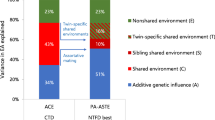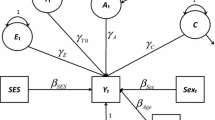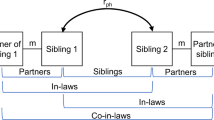Abstract
Phenotypic assortment is assumed to be the principal mechanism of spouse similarity in most biometrical studies. Other assortment mechanisms, such as social homogamy, may be plausible. Two models are presented that consider phenotypic assortment and social homogamy simultaneously (i.e., mixed assortment), where selective associations between social background factors (Model I) versus selective associations between total environments (Model II) distinguish the models. A series of illustrative analyses was undertaken for education and fluid ability available on a sample of 116 Swedish twin pairs and their spouses. On the basis of several fit criteria Model I was preferred over Model II. Both social homogamy and phenotypic assortment may contribute to spouse similarity for educational attainment and fluid ability. Furthermore, spouse similarity for fluid ability may arise indirectly from social homogamy and phenotypic assortment for educational attainment. Power analyses indicated greater observed power for Model I than Model II. Additional power analyses indicated that considerably more twin-spouse sets would be needed for Model II than Model I, to resolve social homogamy and phenotypic assortment. Effects of misspecification of mechanisms of spouse similarity are also briefly discussed.
Similar content being viewed by others
REFERENCES
Akaike, A. C. (1987). Factor analysis and AIC. Psychometrika 52: 317–332.
Baker, L. A., Treloar, S. A., Reynolds, C. A., Heath, A. C., and Martin, N. G. (1996). Genetics of educational attainment in Australian Twins: Sex differences and secular changes. Behav. Genet. 26(2):89–102.
Bentler, P. M., and Bonnet D. G. (1980). Significance tests and goodness of fit in the analysis of covariance structures. Psychol.Bull. 88:588–606.
Bouchard, T. J., Jr., and McGue, M. (1981). Familial studies of intelligence: A review. Science 212:1055–1059.
Carey, G. (1986). A general multivariate approach to linear modeling in human genetics. Am.J.Hum.Genet. 39:775–786.
Cederlöf, R., and Lorich, U. (1978). The Swedish Twin Registry. Prog.Clin.Biol.Res. 24:189–195.
Cloninger, C. R. (1980). Interpretation of intrinsic and extrinsic structural relations by path analysis: theory and applications to assortative mating. Genet.Res.Cambr. 36:133–145.
Crow, J. F., and Felsenstein, J. (1968). The effect of assortative mating on the genetic composition of a population. Soc.Biol. 15(2): 85–97.
Crow, J. F., and Kimura, M. (1970). An Introduction to Population Genetics Theory, Harper & Row, New York.
Crumpacker, D. W., Cederlöf, R., Friberg, L., Kimberling, W. J., Sorensen, S., Vandenberg, S. G., Williams, J. S., McClearn, G. E., Grever, B., Iyer, H., Krier, M. J., Pedersen, N. L., Price, R. A., and Roulette, I. (1979). A twin methodology for the study of genetic and environmental control of variation in human smoking behavior. Acta Genet.Med.Gemellol. 28:173–195.
DeFries, J. C., Johnson, R. C., Kuse, A. R., McClearn, G. E., Mi, M. P., Rashad, M. N., Vandenberg, S. G., and Wilson, J. R. (1976). Parent-offspring resemblance for specific cognitive abilities in two ethnic groups. Nature 261:131–133.
Eaves, L. (1979). The use of twins in the analysis of assortative mating. Heredity 43(3):399–409.
Eaves, L. J., Last, K. A., Young, P. A., and Martin, N. G. (1978). Model-fitting approaches to the analysis of human behavior. Heredity 41(3):249–320.
Eaves, L. J., Fulker, D. W., and Heath, A. C. (1989). The effects of social homogamy and cultural inheritance on the covariances of twins and their parents: A LISREL model. Behav.Genet. 19:113–122.
Eckland, B. K. (1968). Theories of mate selection. Soc.Biol. 15: 71–84.
Falconer, D. S., and Mackay, T. F. C. (1996). Introduction to Quantitative Genetics, 4th ed., Longman Scientific & Technical, London.
Falk, C. T. (1997). Effect of genetic heterogeneity and assortative mating on linkage analysis: A simulation study. Am.J.Hum.Genet. 61:1169–1178.
Fisher, R. A. (1918). The correlations between relatives on the supposition of Mendelian inheritance. Trans.Roy.Soc.Edinburgh 52:399–433.
Flynn, J. R. (1987). Massive IQ gains in 14 nations: What IQ tests really measure. Psychol.Bull. 101:171–191.
Fulker, D. W. (1988). Genetic and cultural transmission in human behavior. In Wei, B. S., Eisen, E. J., Goodman, M., and Namkoong, G. (eds.), Proceedings of the Second International Conference on Quantitative Genetics, Sinaur Associates, Sunderland, MA, pp. 318–340.
Heath, A. C. (1987). The analysis of marital interaction in crosssectional twin data. Acta Genet.Med.Gemellol. 36:41–49.
Heath, A. C., and Eaves, L. J. (1985). Resolving the effects of phenotype and social background on mate selection. Behav.Genet. 15:15–30.
Heath, A. C., Martin, N. G., and Eaves, L. J. (1984). Sense and nonsense in genetic epidemiology: A critique of the statistical model of Williams and Lyer. Acta Genet.Med.Gemellol. 33:557–563.
Heath, A. C., Berg, K., Eaves, L. J., Solaas, M. H., Corey, L., Sundet, J., Magnus, P., and Nancy, W. E. (1985a). Educational policy and the heritability of educational attainment. Nature 314: 734–736.
Heath, A. C., Kendler, K. S., Eaves, L. J., and Markell, D. (1985b). The resolution of cultural and biological inheritance: Informativeness of different relationships. Behav.Genet. 15(5):439–465.
Heath, A. C., Eaves, L. J., Nance, W. E., and Corey, L. A. (1987). Social inequality and assortative mating: Cause or consequence? Behav.Genet. 17(1):9–17.
Hirsch, J. (1967). Behavior-genetic, or “experimental,” analysis: The challenge of science versus the lure of technology. Am.Psychol. 22:118–130.
Hollingshead, A. B. (1950). Cultural factors in the selection of marriage mates. Am.Sociol.Rev. 15:619–627.
Lichtenstein, P., and Pedersen, N. L. (1997). Does genetic variance for cognitive abilities account for genetic variance in educational achievement and occupational status? A study of twins reared apart and twins reared together. Soc.Biol. 44(1–2):77–90.
Lichtenstein, P., Pedersen, N. L., and McClearn, G. E. (1992). The origins of individual differences in occupational status and educational level. Acta Sociol. 35:13–31.
Lykken, D. T., and Tellegen, A. (1993). Is human mating adventitious or the result of lawful choice? J.Person.Soc.Psychol. 65(1):56–68.
Mare, R. D. (1991). Five decades of educational assortative mating. Am.Sociol.Rev. 56:15–32.
Mascie-Taylor, C. G. N. (1989). Spouse similarity for IQ and personality and convergence. Behav.Genet. 19(2):223–227.
Mascie-Taylor, C. G. N., and Vandenberg, S. G. (1988). Assortative mating for IQ and personality due to propinquity and personal preference. Behav.Genet. 18(3):339–345.
Nagoshi, C. T., Johnson, R. C., and Ahern, F. M. (1987). Phenotypic assortative mating vs. social homogamy among Japanese and Chinese parents in the Hawaii Family Study of Cognition. Behav.Genet. 17(5):477–485.
Neale, M. C., Boker, S. M., Xie, G., and Maes, H. (1999). Mx: Statistical Modeling, 5th ed., VCU Box 900126, Department of Psychiatry, Richmond, VA 23298.
Phillips, K. (1989). Delta path methods for modeling the effects of multiple selective associations in adoption designs. Behav.Genet. 19:609–620.
Phillips, K., Fulker, D. W., Carey, G., and Nagoshi, C. T. (1988). Direct marital assortment for cognitive and personality variables. Behav.Genet. 18(3):347–356.
Plomin, R., and Petrill, S. A. (1997). Intelligence: What's new? Intelligence 24(1):53–77.
Plomin, R., Fulker D. W., Corley R., and DeFries, J. C. (1997). Nature, nurture, and cognitive development from 1 to 16 years: A parent-offspring adoption study. Psychol.Sci. 8(6):442–447.
Rao, D. C., Morton, N. E., and Yee, S. (1976). Resolution of cultural and biological inheritance by path analysis. Am.J.Hum.Genet. 28:399–409.
Rao, D. C., Morton, N. E., and Cloninger, C. R. (1979). Path analysis under generalized assortative mating. I. Theory. Genet.Res. 33:175–188.
Raven, J. C. (1952). Guide to Using Progressive Matrices, H. K. Lewis, London.
Reynolds, C. A., Baker, L. A., and Pedersen, N. L. (1996). Models of spouse similarity: Applications to fluid ability measured in twins and spouses. Behav.Genet. 26:73–88.
Rice, J., Cloninger, C. R., and Reich, T. (1978). Multifactorial inheritance with cultural transmission and assortative mating. I. Description and basic properties of the unitary models. Am.J.Hum. Genet. 30:618–643.
Tambs, K., Sundet, J. M., Magnus, P., and Berg, K. (1989). Genetic and environmental contributions to the covariance between occupational status, educational attainment, and IQ: A study of twins. Behav.Genet. 19(2):209–211.
Tambs, K., Sundet, J. M., and Berg, K. (1993). Correlations between identical twins and their spouses suggest social homogamy for intelligence in Norway. Person.Indiv.Diff. 14(1):279–281.
Tucker, L. R., and Lewis, C. (1973). A reliability coefficient for maximum likelihood factor analysis. Psychometrika 38:1–10.
Van Eerdewegh, P. (1982). Statistical Selection in Multivariate Systems with Applications in Quantitative Genetics, Unpublished doctoral thesis, Washington University, St. Louis, MO.
Vogler, G. P., and Fulker, D. W. (1983). Familial resemblance for educational attainment. Behav.Genet. 13(4):341–354.
Watkins, M. P., and Meredith, W. (1981). Spouse similarity in newlyweds with respect to specific cognitive abilities, socioeconomic status, and education. Behav.Genet. 11(1):1–21.
Wright, S. (1968). Evolution and the Genetics of Populations, Vol.I. Genetics and Biometric Foundations, University of Chicago Press, Chicago.
Wright, S. (1978). Evolution and the Genetics of Populations, Vol.4. Variability Within and Among Natural Populations, University of Chicago Press, Chicago.
Author information
Authors and Affiliations
Rights and permissions
About this article
Cite this article
Reynolds, C.A., Baker, L.A. & Pedersen, N.L. Multivariate Models of Mixed Assortment: Phenotypic Assortment and Social Homogamy for Education and Fluid Ability. Behav Genet 30, 455–476 (2000). https://doi.org/10.1023/A:1010250818089
Issue Date:
DOI: https://doi.org/10.1023/A:1010250818089




